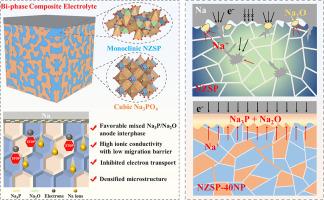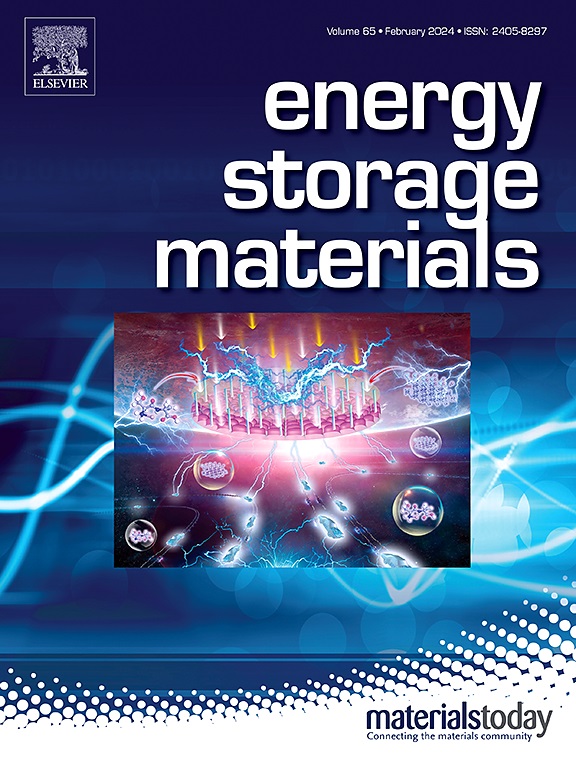在新型双相 Na3Zr2Si2PO12/Na3PO4 固体电解质上自形成 Na3P/Na2O 相,用于长循环固态钠金属电池
IF 18.9
1区 材料科学
Q1 CHEMISTRY, PHYSICAL
引用次数: 0
摘要
本文章由计算机程序翻译,如有差异,请以英文原文为准。

Self-forming Na3P/Na2O interphase on a novel biphasic Na3Zr2Si2PO12/Na3PO4 solid electrolyte for long-cycling solid-state Na-metal batteries
A novel biphasic Na3Zr2Si2PO12/Na3PO4 solid electrolyte is proposed to effectively address critical anode interface challenges for solid-state Na-metal batteries (SSSMBs). The Na3PO4 phase, at an optimal composition of ∼20 mol%, transforms the interface chemistry throughout the NZSP electrolyte, which results in dense electrolytes with high Young's modulus, rapid ion transport (6.2 × 10-4 S cm-1) at low activation barrier (0.19 eV), negligible electronic conductivity, and excellent sodiophilicity. The AIMD/DFT calculations and XPS analysis reveal a self-formed, (electro)chemically stable mixed Na+/electron-conducting interphase, comprising Na3P and Na2O, at the Na anode interface. The interphase not only homogenizes the Na+ flux distribution and accelerates the interfacial charge transport, but prevents continuous interfacial reactions, thereby stabilizing the anode interface against dendrite formation. Benefiting from the low-impedance, dendrite-free anode interface, Na symmetric cells demonstrate a low interface resistance of 12.7 Ω cm2 and exceptional cyclability of 3000 hours. Additionally, full cells with Na3V2(PO4)3 cathodes achieve 93% capacity retention after 550 cycles at 0.5 C. This research comprehensively elucidates and leverages the critical advantages of Na3PO4 in enhancing the bulk and interface properties of Na3Zr2Si2PO12 solid electrolytes. The design strategy of biphasic solid electrolytes presented here offers new insights into the developing high-performance solid electrolytes for advanced SSSMBs.
求助全文
通过发布文献求助,成功后即可免费获取论文全文。
去求助
来源期刊

Energy Storage Materials
Materials Science-General Materials Science
CiteScore
33.00
自引率
5.90%
发文量
652
审稿时长
27 days
期刊介绍:
Energy Storage Materials is a global interdisciplinary journal dedicated to sharing scientific and technological advancements in materials and devices for advanced energy storage and related energy conversion, such as in metal-O2 batteries. The journal features comprehensive research articles, including full papers and short communications, as well as authoritative feature articles and reviews by leading experts in the field.
Energy Storage Materials covers a wide range of topics, including the synthesis, fabrication, structure, properties, performance, and technological applications of energy storage materials. Additionally, the journal explores strategies, policies, and developments in the field of energy storage materials and devices for sustainable energy.
Published papers are selected based on their scientific and technological significance, their ability to provide valuable new knowledge, and their relevance to the international research community.
 求助内容:
求助内容: 应助结果提醒方式:
应助结果提醒方式:


